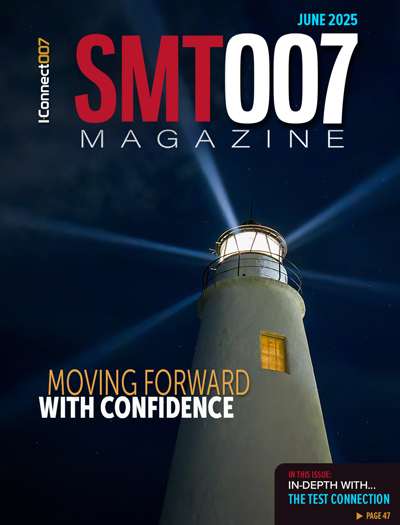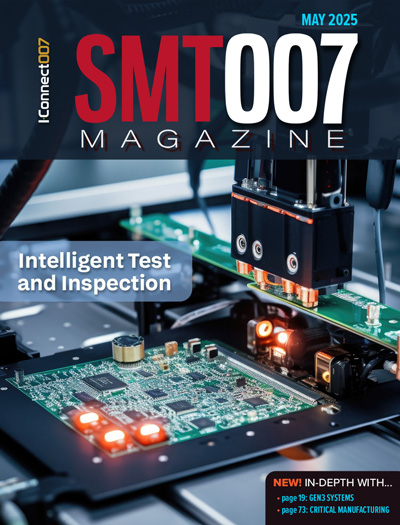-

-
News
News Highlights
- Books
Featured Books
- smt007 Magazine
Latest Issues
Current Issue
What's Your Sweet Spot?
Are you in a niche that’s growing or shrinking? Is it time to reassess and refocus? We spotlight companies thriving by redefining or reinforcing their niche. What are their insights?

Moving Forward With Confidence
In this issue, we focus on sales and quoting, workforce training, new IPC leadership in the U.S. and Canada, the effects of tariffs, CFX standards, and much more—all designed to provide perspective as you move through the cloud bank of today's shifting economic market.

Intelligent Test and Inspection
Are you ready to explore the cutting-edge advancements shaping the electronics manufacturing industry? The May 2025 issue of SMT007 Magazine is packed with insights, innovations, and expert perspectives that you won’t want to miss.
- Articles
- Columns
- Links
- Media kit
||| MENU - smt007 Magazine
To Bake or Not to Bake: Examining the Impact of Waiving PCB Pre-Baking Prior to Assembly
November 15, 2016 | Yash Sutariya, Saturn Electronics/Saturn Flex SystemsEstimated reading time: 1 minute
I’ll always remember the summer of 2004 as the “Summer of Lead-Free.” Finally, Pb-free circuit boards were going into standard production mode. Assemblers focused the majority of their efforts (often at my behest) on final finish and proper laminate selection. What none of us saw coming, however, was the rash of delamination that would burn the entire industry during that long, hot lead-free summer.
After a good amount of research, Isola came up with a Lead-Free PCB Fabrication and Assembly Guideline that outlined various steps in the PCB fabrication and assembly processes that are critical to successful lead-free PCB assemblies. The most prominent process step that was added in this guideline is baking—during fabrication and, most critically, just prior to assembly. The goal of baking is simply to drive moisture out of the PCB.
Moisture plays a critical role in lead-free PCB assembly. Therefore, it is important to discern the specifications of your base laminate. One knee-jerk reaction of North American PCB users was to specify what they believed to be the highest end laminates, those that qualify under IPC 4101/126 and /129 slash sheets. These are typically phenolic-cured materials, which have much higher thermal properties in terms of glass transition temperature (Tg) and decomposition temperature (Td) that are required to survive lead-free assembly without via failure.
Unfortunately, other properties of the laminate and assembly temperatures create a perfect storm for reliability failures. These include: moisture absorption, interlaminate adhesion strength, and water vapor pressure at lead-free assembly temperatures.
Moisture Absorption
Moisture absorption of phenolic materials is more than 2x as compared to traditional FR-4 materials that qualify under IPC 4101/21. In the early days, the technical data sheets used a 0.028" thickness core material for moisture absorption measurement. Based on this test vehicle, phenolic laminates showed moisture absorption of 0.45%; comparatively standard FR-4 laminates scored a 0.20% rate of moisture absorption. Over time, I think someone got wise and changed the test vehicle to a 0.059" thickness core, thereby increasing the denominator of the weight loss calculation. This resulted in a moisture absorption rate of 0.20%, matching the rate of standard FR-4 laminate.
To read this entire article, which appeared in the November 2016 issue of SMT Magazine, click here.
Testimonial
"In a year when every marketing dollar mattered, I chose to keep I-Connect007 in our 2025 plan. Their commitment to high-quality, insightful content aligns with Koh Young’s values and helps readers navigate a changing industry. "
Brent Fischthal - Koh YoungSuggested Items
Dispense Works RPX Series Robotic Dispensing Machines for Precision Assembly and Custom Automation
07/18/2025 | Dispense Works Inc.Dispense Works Inc., a leader in automated dispensing and precision assembly solutions, offers the RPX Series of robotic dispensing systems.
INSPECTIS AB ‘Makes it a Meal’ with Series U50s Advanced Kit
07/18/2025 | INSPECTIS ABFamous chefs the world over maintain that an entrée doesn’t make a great meal without side dishes. At INSPECTIS, we call those ‘sides’ an Advanced Kit.
Technica USA Introduces Frank Silva as PCBA Representative for Southern CA and Southern NV Territories
07/16/2025 | Technica USATechnica USA is pleased to announce the partnership with veteran Frank Silva as our PCBA Sales Representative, supporting both supply partners and PCBA customers across Southern California and Southern Nevada.
Staying—and Excelling—in Their Lane
07/16/2025 | Nolan Johnson, SMT007 MagazineMichael Seltzer, chief commercial officer at Zentech Manufacturing, helps define his company’s niche and why it has mattered to them over nearly three decades. Should a company shift with the markets or stay true to its mission? Find out how Michael has helped the company truly understand its vision.
Electronics Manufacturing & Assembly Collaborative (EMAC) Announces Innovative Student Competition
07/15/2025 | EMACThe Electronics Manufacturing & Assembly Collaborative (EMAC) recently announced the launch of the Bright Manufacturing Challenge 2025, a revolutionary hands-on competition that transforms how students experience electronics manufacturing and robotics engineering.


